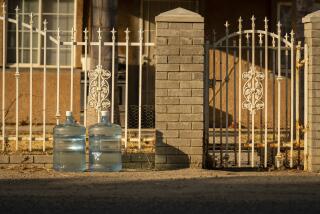Bill heats up talk of solar water systems
At first glance, the ranch-style stucco house on a quiet Encino street looks no different from its neighbors. A manicured lawn. A bottlebrush tree. Two cars in the driveway. You couldn’t tell, unless you climbed a ladder or glanced into the utility shed, that Richard and Barbara Braun’s home is a foot soldier in the war against global warming.
On a south-facing slant of the roof, two solar panels warm pipes of circulating water for showers, dishwashing and laundry.
“It’s simple -- no complicated parts,” said Braun, a retired surgeon.
A bill aimed at making such heating systems widely available is expected to move through the state Assembly’s Appropriation Committee on Wednesday and to the full body next week.
But the bill, which would offer $250 million in incentives to build 200,000 solar water systems statewide over the next 10 years, is running into opposition from gas and electric companies. They don’t want the plan funded through a surcharge on residential and commercial gas bills.
“It’s a noble effort,” said Avis Kowalewski, vice president for Western Regulatory Affairs at Calpine Corp., which owns 22 gas-fueled power plants in the state. “But this bill could cost our company alone between $14 million and $18 million over 10 years.”
But residential gas users would pay only about 13 cents a month extra, according to the California Public Utilities Commission. And the benefits could be substantial.
Studies by KEMA-Xenergy, an energy consulting firm, show that using solar systems in California homes and businesses with access to sunlight could cut the use of residential natural gas by about 24% and reduce total statewide consumption by more than 5%, said Assemblyman Jared Huffman (D-San Rafael), the bill’s author.
Though natural gas is cleaner than oil or coal, its burning still spews carbon dioxide and other greenhouse gases into the atmosphere and is a major cause of climate change, experts say.
“This is one of the simplest, easiest steps we can take to reduce our dependence on fossil fuels,” Huffman said.
Although a federal tax credit currently exists for installation of solar water heaters, no state subsidies have been available since the mid-1980s, when generous incentives were allowed to expire.
Last year, California enacted a “million solar roofs” bill, which allocates $3.2 billion in rebates for solar photovoltaic panels -- a sophisticated silicon-based technology -- that replace electricity. But the final law excluded solar water heaters.
A residential solar water heating system can cost $4,000 to $6,000, but with the incentives proposed under Huffman’s bill, consumers could recoup their costs in less than 10 years through reduced gas bills. On average, a solar system takes the place of about 75% of the gas normally used in a home.
When Braun installed a solar water system 30 years ago, he had four children and a niece living in the house.
“We saved a third of our gas bill,” he said. Now with only himself and his wife at home, “The gas is rarely on.”
For hotels, restaurants, apartment buildings and other big hot water users, the savings can make the difference between profit and loss.
“They’ve performed very well and saved me a bundle,” said William McLaughlin, who installed solar water heaters in the 1980s on three of his Inglewood apartment buildings and on his own house in Rancho Palos Verdes.
On one 28-unit building, which features 26 panels, the monthly gas bill runs $400, but “without solar, it would be $1,000,” McLaughlin said.
Unlike solar photovoltaic electricity, the technology for solar water heaters, also known as solar thermal, is hardly new. The world’s first solar water heater was patented in the U.S. in 1891. By 1897, a third of all Pasadena homes had them. But with the discovery of cheap natural gas in the Los Angeles Basin in the 1920s, solar went out of fashion.
The 1970s energy crisis revived the industry. Federal and state subsidies that together covered 80% of costs led to a proliferation of fly-by-night installers charging high prices. Solar water heating got a bad name, and when the energy crisis lifted, subsidies dried up and the industry all but collapsed. Last year, only 1,000 solar water heaters were installed in all of California. Nationwide, 9,000 were installed, nearly half in Hawaii, where hefty rebates are offered.
In the meantime, improved technology and higher fuel prices are boosting the use of solar thermal around the world. Installations jumped 14% in 2005, bringing the worldwide total to 46 million homes. In Israel, 90% of homes have solar water heaters. Even Austria, with its chilly climate, installed 40 times more systems in 2005 than California -- although it has a quarter of the population.
In opposing the bill, Calpine is joined by San Francisco-based Pacific Gas & Electric and San Diego-based Sempra Energy, which owns Southern California Gas Co. and San Diego Gas & Electric Co. But the gas companies and Huffman said they would work to forge a compromise.
There are signs that momentum is building for solar water heating, especially with mounting opposition to proposed liquid natural gas terminals.
A pilot program, sponsored by the Public Utilities Commission, will subsidize 750 installations in San Diego beginning this summer.
Today, homeowners and businesses are wary of the upfront costs of solar heating. But “the legislation will create a large enough market that prices will drop and it will become cost-effective in time,” said Bernadette Del Chiaro, an energy expert for the advocacy group Environment California who helped draft the bill.
*
(BEGIN TEXT OF INFOBOX)
Here comes the sun
The United States lags behind many countries in the use of solar energy to heat water.
Heating water with solar energy
Percent of each country’s total hot water generation produced by solar energy in 2005
China: 62%
Rest of the world: 17%
EU: 13%
Japan: 6%
U.S.: 2%
Typical system
Generally, solar water heaters work either by heating the water directly or via a heat-transfer fluid. Hot water is stored in a tank until needed.
Rooftop collector
Storage tank or backup heater
Solar-heated tap water
Source: Environment California Research and Policy Center
More to Read
Inside the business of entertainment
The Wide Shot brings you news, analysis and insights on everything from streaming wars to production — and what it all means for the future.
You may occasionally receive promotional content from the Los Angeles Times.











